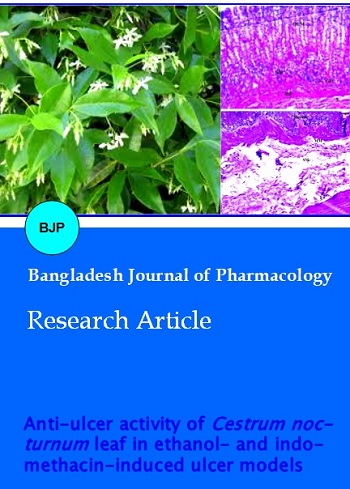Anti-ulcer activity of Cestrum nocturnum leaf in ethanol- and indomethacin-induced ulcer models
DOI:
https://doi.org/10.3329/bjp.v12i3.32790Keywords:
Anti-ulcer activity, Cestrum nocturnum, IndomethacinAbstract
This study was planned to explore the antiulcer activity of the methanolic and n-hexane extracts of Cestrum nocturnum leaf against ethanol- and indomethacin-induced ulcer models in rats. The rats were administered orally vehicle in normal control group, methanolic and n-hexane extracts at doses 300, 500, 700 mg/kg, in treated groups and omeprazole 20 mg/kg, as standard drug. The gastric tissues/contents were examined to determine the ulcer index, antiulcer activity, gastric pH, gastric juice volume and acidity. Both extracts showed dose-dependent increase in antiulcer activity (%) in both ulcer models. Histopathology also supported these results. Gastric pH significantly increased while the gastric juice and acidity significantly decreased in the treatment groups of both ulcer models indicating the anti-secretory effect of extracts. It may be concluded that C. nocturnum protect gastric mucosa by decreasing gastric juice, acidity and increasing the gastric pH.
Video Clip of Methodology:
6 min 58 sec: Full Screen Alternate
Downloads
141
134 Read
22

Published
How to Cite
Issue
Section
License
Authors who publish with this journal agree to the following terms:
- Authors retain copyright and grant the journal right of first publication with the work simultaneously licensed under a Creative Commons Attribution License that allows others to share the work with an acknowledgement of the work's authorship and initial publication in this journal.
- Authors are able to enter into separate, additional contractual arrangements for the non-exclusive distribution of the journal's published version of the work (e.g., post it to an institutional repository or publish it in a book), with an acknowledgement of its initial publication in this journal.
- Authors are permitted and encouraged to post their work online (e.g., in institutional repositories or on their website) prior to and during the submission process, as it can lead to productive exchanges, as well as earlier and greater citation of published work (See The Effect of Open Access).
